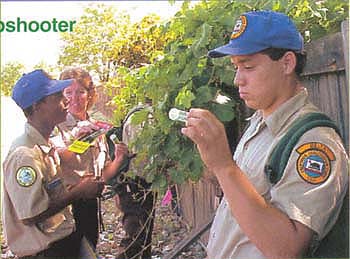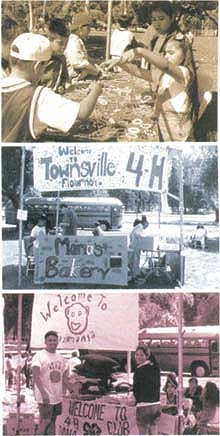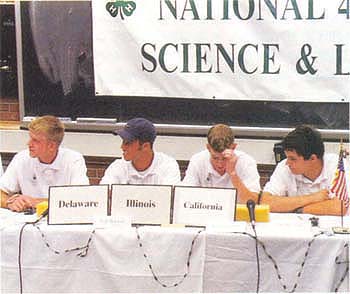All Issues
4-H “national conversation” garners new ideas for youth development
Publication Information
California Agriculture 56(2):46-47.
Published March 01, 2002
PDF | Citation | Permissions
Full text
Youth development and educational organizations around the country have been participating in a series of conversations convened by 4-H, aimed at improving the future for America's youth.
These discussions began last fall, as county 4-H programs invited youth, adult leaders, parents, teachers and others to come together to jointly explore what actions can be taken to help the young people in their communities lead successful lives. Their priorities were then taken up at “state conversations” organized by the umbrella 4-H organization in each of the 50 states and five U.S. territories.
Finally, on Feb. 28, more than a thousand individuals from across the nation convened in Washington, D.C., for a 3-day “national conversation” to mold the best ideas into a national action plan. The plan will be presented to President Bush, U.S. Department of Agriculture (USDA) Secretary Veneman and Congress in April.
“It's exciting to be involved in something that has the potential to have a dramatic impact on the young people of this state and the nation,” says Carole MacNeil, statewide director of the California 4-H Youth Development Program. “We're creating a blueprint for youth programs that could be used in any community in America.” About 35 organizations participated in the California state conversation.
The nationwide conversations mark a centennial being observed this year by the National 4-H Council, celebrating the formation of the first out-of-school boys and girls clubs, which eventually became 4-H.
Although 4-H has its roots in agricultural clubs at the turn of the last century, its focus today is on helping young people from all backgrounds fulfill their potential. More than 30% of the nearly 7 million young people in 4-H nationwide are from minority racial or ethnic groups. And just 1 in 10 of its members lives on a farm; almost 60% reside in suburbs, towns and cities, including in inner-city communities. According to the National 4-H Council, 4-H is now one of the nation's most diverse organizations, serving youth in all economic, racial, social and geographic categories.
Programs serve diverse clientele
The California 4-H Youth Development Program illustrates this trend. It delivers a rich mix of innovative educational activities for use in a variety of settings beyond the traditional 4-H club, including during, before and after-school programs.
California 4-H, a program of the UC Division of Agriculture and Natural Resources (ANR), taps the research and educational resources at UC and other institutions of higher learning to provide curriculums in dozens of subjects, ranging from math and environmental science and rocketry to money management and career preparation.
Here are a few examples of the work under way in California 4-H:
World of Work study
Researchers with the 4-H Center for Youth Development at UC Davis collaborated with 4-H advisors in six counties to study what factors shape the choices young people make about a career and education after high school. The study, “Preparing Adolescents for the World of Work,” revealed important differences among ethnic groups. The findings are being widely disseminated ( see p. 48 - 64 ) and used to craft new 4-H curriculum.
Animal Ambassadors
Directed by Martin Smith of UC Davis Veterinary Medicine Extension, the Animal Ambassadors program encourages interest in science through exploration of the world of animals, with a hands-on, inquiry-based approach that emphasizes scientific thinking. Older teens act as mentors to younger learners. “We found a positive trend in the family's involvement in the child's science education,” says 4-H advisor Richard Enfield, who co-developed the program and helped implement it in San Luis Obispo County.
Homework Club
A 2-year collaboration between 4-H, school principals, teachers and parents, the Homework Club meets for 1.5 hours after school, 4 days a week. Aides assist small groups of children in grades 3 to 5 with their homework and reading assignments. “There's been an increase of 33.3% in the number of students turning in homework 100% of the time,” says Tehama and Glenn counties 4-H advisor Jeanne George. Ninety-five percent of students, many from Spanish-speaking families, said they became better students and over 92% of parents said the club improved their child's self-image and school success.
CCC searches for glassy-winged sharpshooterSince May 2000, the California Conservation Corps (CCC) — the state program that combines youth development with natural resources protection ( see p. 61 ) — has been helping to combat the glassy-winged sharpshooter. The nonnative sharp-shooter spreads the pathogen that causes Pierce's disease, which can kill grapevines. CCC members have been trained to identify larvae and other signs of the sharpshooter, and to capture the insects. To date they have provided more than 77,000 hours of assistance in 11 counties, in conjunction with county agricultural commissioners and the California Department of Food and Agriculture.
YES
Teen teachers in the Youth Experiences in Science (YES) project bring hands-on science education to young elementary school students after school. Developed by UC Cooperative Extension youth development specialist Richard Ponzio and 4-H advisor Sharon Junge, YES is now used nationwide. In Sacramento County, the 4-H YES program partners with Sacramento START to reach children in lower income areas.
Junior Master Gardeners
Developed by Texas A&M University's extension service, the Junior Master Gardener program was introduced in California 2 years ago by 4-H program representative Susan Gloeckler and 4-H advisor Dan Desmond. “It's a fun program, yet educational and easy for the teachers,” Gloeckler says. Kids learn basic concepts in horticulture, ecology, nutrition and health, and participate in leadership and community service activities. The program is also available in Spanish.
4-H Computer Corps
The 14 young people of the 4-H Computer Corps are the webmasters for the California 4-H statewide Web site. They also lead computer workshops at 4-H events and assist local 4-H clubs in developing Web sites. They learn computer technology, teaching, writing and editing, as well as organizational communications and behaviors.
Migrant education
For 10 years, Orange County 4-H advisor Mike Mann has been a partner with the Santa Ana Unified School District in a local migrant education program. He facilitates training for the bilingual staff in how to help children of migrant workers build basic leadership communications skills. Each year up to 10 high school kids receive scholarships from ANR, and the district pays travel costs to send them to the statewide 4-H leadership conference.
“The kids really enjoy it,” Mann says. “These activities and lessons in basic leadership skills are normally not available to them.”
School enrichment
Fresno County 4-H advisor Dave Snell established the 4-H School Enrichment Program to teach basic science and physics concepts as well as improve agricultural literacy. Since 1992, more than 72,000 elementary students have participated in the 3- to 6-week program, which provides curriculum and classroom materials in avian embryology, plant science and water rockets. Snell and his assistants also provide in-service to classroom teachers.
California high school students participated in an “engineering bowl” at the National 4-H Engineering, Science and Leadership Event at Purdue University in 1999.







